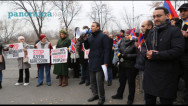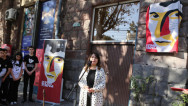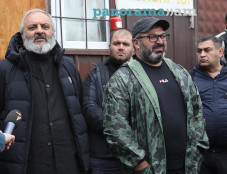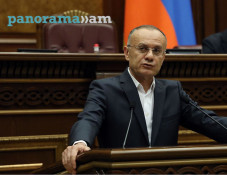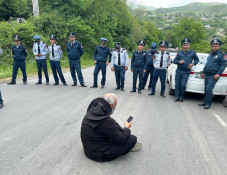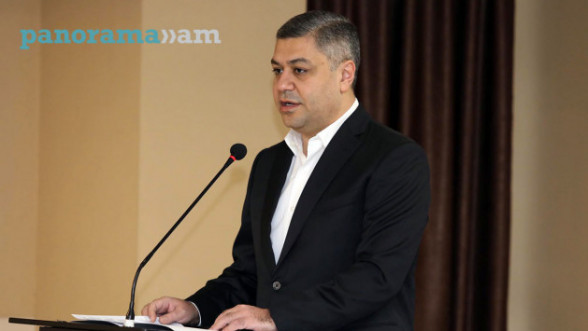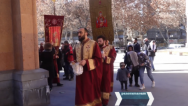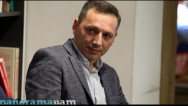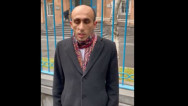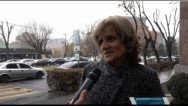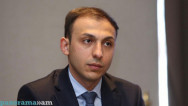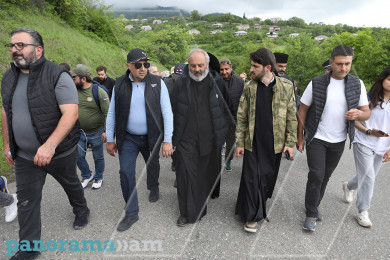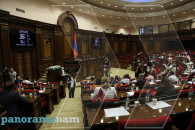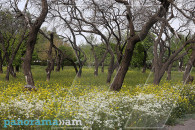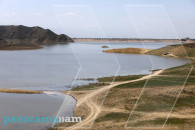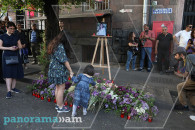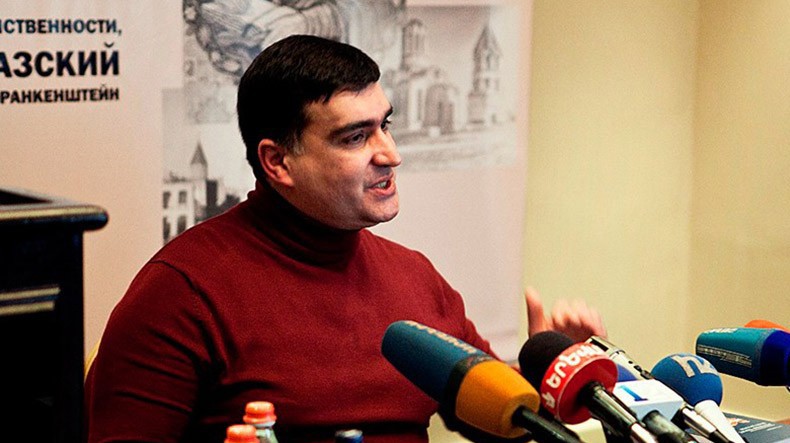
Aris Ghazinyan: According to famous anthropologists, Armenians are descendants of ancient indigenous race, which preserved its type from any influence
The cultural adaptation of the territory of modern Yerevan began tens of thousands of years ago. Determined by radiocarbon dating, the absolute age for the upper and the lower borders of only one layer №4 of Palaeolithic cave station “Yerevan I” was 49,000 and 47,800 years respectively. Armenian journalist and researcher Aris Ghazinyan writes about it in the preface of his book “Yerevan: with a cross or on the cross,” which is an attempt of setting and considering an extremely diverse range of processes directly or indirectly forming the character of the development of the territory in question and predetermining the inevitability of turning Yerevan into the main centre of the Eastern Armenia, and later on into the capital of the recovered Armenian state.
According to the author, by that time, the Mousterian archaeological culture was already formed in a quite extensive territory. “During the Mousterian period, people started to render habitable rocky niches located near stable streams. One of these caves, today known to archaeological communities by the scientific name ‘Yerevan I,’ was chosen by paleoanthropologists on the right bank of Hrazdan river,” Ghazinyan writes.
The most famous agricultural-cattle breeding settlement within the boundaries of modern Yerevan is an ancient settlement located on the bank of Hrazdan river, known by the name “Shengavit.” “The earlier layers of the monument belong to the Neolithic Era, dated in the territory of the Ararat Plain in 6th-5th millennia BC,” the author writes. The high level of development of cattle breeding is indicated by the fact that animals were directly tamed in the place, and were not driven from other areas. The osteological material pointing out to the fact that Yerevan is one of the independent centres of primary domestication also proves that.
Brachycranial skulls typical to representatives of the so-called “Armenoid race” also occupy a prominent place among archaeological materials of Shengavit. Representatives of different ethno-cultural belonging – Armenians, separate groups of Arabian population, Iranians, Assyrians, Jews – are all bearers of this anthropological type.
Ghazinyan cites the anthropologist Felix von Luschan, according to whom, the Armenians are the descendants of an ancient indigenous race, which kept its type away from any influence. It was Luschan who named armenoid the ancient skulls found in the Armenian highlands. For his part, the founder of the Soviet anthropological school Viktor Bunak emphasised that the Semitic type was present only for a limited period of time, later the Armenoid type began to dominate. It is impossible to state any other race elements in the ancient population of the Western Asia.
“At the boundary of 5th-4th millennia, people inhabiting the area began to constantly use copper, which gave an unprecedented impulse to the development of their civilization. Ceramic forms and bakes for metal moulding, as well as a great number of metal instruments of labour were found in the territory of Yerevan,” Ghazinyan continues.
Regarding the cultural adaptation of the territory of modern Yerevan, Ghazinyan notes that it was intensified during the subsequent periods. In 3rd-2nd millennia BC, agricultural and cattle breeding settlements with a high level of organization existed here, for example, pre-Urartian Karmir Blur, Mukhannat-tapa, Norabats, Tsitsernakaberd, and others.
Revolutionary changes took place in the area in the beginning of I millennium BC, when it became a part of “the young and ambitious monarchy” of the Urartu kingdom, the core of formation of which was situated in the western part of Armenia, in the region of the mountainous lake Van. “The zenith of the power of the Urartu Kingdom came in the period of almost thirty-year (from 787 to 750 BC) reign of Argishti I. This invincible monarch of the ancient east, before whom even Assyria confessed its powerlessness, became the founder of Yerevan. In the fifth year of his reign, he started laying an important military centre, about which he left a cuneiform inscription: ‘By the greatness of the God Khaldi, Argishti, son of Menua, built this mighty stronghold and proclaimed it Erebuni for the glory of Biainili and to instill fear among the king's enemies.’,” Ghazinyan writes, noting that the etymological roots of the name of the modern Armenian capital derive from the name of Erebuni Fortress.
And just after the founding of the fortress, for a certain period of time, the centre of the political life of the Ararat plain moved to Erebuni hills, among which is Arinberd, marked out in the foreground.
“The first documented message about a certain demographic policy carried out within Yerevan’s boundaries by a certain king also dates back to the early 8th century BC. Argishti I’s extant message informs about resettlement of over six thousand souls from the western provinces of Hatti (the territory, which had by that time emerged from the historical arena of the Hittite State on the right bank of the river Euphrates) and Tsupani (the area of confluence of the river Aratsani in Euphrates proper) into Erebuni,” Ghazinyan writes.
He cites Igor Diakonoff who maintains that the practice of resettling ethnic masses, including resettlements to quite far distances, applied in Urartu must have played a certain role in spreading the Armenian language as a language of mutual understanding, and later as the only language across the entire highland. “However, for the Armenian language (rather than any other) to be able to play the role of a language of mutual understanding, it was necessary to have already been used as such earlier, at the junction of different ethnic groups,” Diakonoff writes as cited by Ghazinyan.
Archaeological findings evidence that the city was an active participant of international trade in that period. “Commercial deals constituted barters then. Rusa II, the founder of the city Teishebaini, took the throne exactly at the time when the first embossed coin appeared in Lydia. That is why the commodity-money relations were not in practice yet,” he writes.
The period between the 6th and 5th centuries BC is the era of a parallel use of the two identical concepts ‘Urartu’ and ‘Armenia.’ The appeals found in Gadd’s Chronicles (Babylonian chronicle) and in the speeches of Judaic prophets, dating back to the late 7th and early 6th centuries BC, can be considered the first examples of such overlaps. Later, the identification of the two concepts became even more univocal. Moreover, this was projected onto both the name of the country and its population (for some period, the term ‘urart’ remained popular in the Semite world – Babylonian and other – but with the meaning ‘Armenian’ rather than ‘a national of Urartu’). According to Muhammad Dandamayev and Vladimir Lukonin, “the name of ‘urarty’ is an anachronism and denotes the Armenians in that period,” Ghazninyan writes.
As the Achaemenid Empire was established, Erebuni – which was already called Yerevan at that time – became one of the most important cities in the 18th satrapy or even its centre. Ghazinyan writes that the united satrapy ‘Armenia’ was divided into two regions during Xerxes’ reign. “The period of the formation of satrapies and of the establishment of a news system of governing coincided with the time of final adopting Zoroastrianism as the official religion of the Achaemenid Empire. In accordance with the ideological demands of the time, ancient cult structures were subjected to fundamental changes,” he writes and notes that the reconstruction was affected by the principles of the development of the Zoroastrian architecture.
Remarkably, Yerevan is the only region in the territory of the Republic of Armenia, where a whole palace building, Erebuni Apadana, is preserved, apart from fragments of structures of the Achaemenid period.
Excavations also revealed ties with the Greek-Ionian and Western Asian worlds. In addition, silver coins of Milesian milting of 5th century BC were found near the temple Susi to confirm not only the period (time) of the reconstruction of the temple area, but also to reinforce the fact of the existence of monetary circulation within the boundaries of Yerevan.
“Therefore, all the claims that the cultural adaptation of the area of Yerevan began only in the 16th century thanks to the Turkic magnates’ efforts, are an object of pan-Turkic ideological speculations and a fruit of fantasies about a shadow history. Politically motivated, they are of pseudohistorical nature,” Ghazinyan concludes. He also adds that the life in the territory of the city has never died away, but developed in all the historical periods.
It is something else that between the 5th century BC and 7th century AD, the area lost the significance it used to enjoy in the first half of the 1st millennium BC. Various archaeological monuments of Hellenistic and Early Medieval periods remaining intact in the territory of Yerevan also prove that the place went on developing even in the shadow of other Armenian cities, he writes.
To be continued.
Aris Ghazinyan’s “Yerevan: with a cross or on the cross” is a book about the social and political history of Yerevan and Yerevan district (as a habitat) since the declaration of Christianity to the beginning of XIX century. In addition to demonstrating historical facts based on archive documents and sources, the book also considers the fundamental theses of the Azerbaijani historiography and Pan-Turkic ideology aimed at appropriating the historical, cultural, and spiritual heritage of the Armenians and other nations of the region by falsifying their history.
Related news
- Aris Ghazinyan: According to orientalist Diakonoff's memories, most of Azerbaijani historians had “quite indirect relation” to science
- Aris Ghazinyan: Politicians and scientists in Turkey and Azerbaijan completely ignore primary sources on Yerevan history
- Aris Ghazinyan: Past and future in Azerbaijan are modeled upon decrees and program speeches of president
- ‘Polygon Azerbaijan’: Azerbaijan’s true history ‘in context of global political processes’
Newsfeed
Videos



